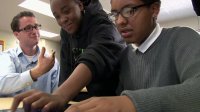Using Video Observations to Improve Teaching
Teachers pair up to record each other’s classes and offer feedback to improve their practice.
Tips for Videotaping a Class
We asked Mike and Rose how to go about videotaping and reviewing a colleague's class. Here are their suggestions:
What do you look for when you shoot video of your partner?
When shooting video, the biggest concern is actually the audio. Students, particularly teenagers, tend to speak in a low voice. We use a handheld, external shotgun mic for audio. An onboard mic rarely picks up students from across the room, and when you’re trying to pick out a single voice in a room that has ambient noise, it is tough to get a clear recording. The mic input on our camera lets us use our external shotgun mic to target individual student voices, even from across the room.
Besides audio, we usually capture the posted objective for the day regardless of what we are focusing on because this helps us when we’re looking at old footage. Then we spend most of our time trying to see what the students are doing. Most people make the mistake of capturing the teacher almost exclusively. Although that is helpful if one is trying to analyze a presentation style or a specific pedagogy, if the goal is to analyze a lesson, you should focus on the students. What students are actually doing can be different from the stated objective or task for many reasons. Generally, the most important things to focus on are what we are asking our students to do and how well they are able to do it. Capture student work samples -- by zooming in on papers -- and move in to capture conversations whenever possible to make later analysis richer.
One thing to note: How a teacher presents the camera to the students matters. We always say we’re recording our teaching so we can analyze it and get better as teachers, the way athletes do with their performances. Students will eventually tune out the camera as it becomes the norm.
If I were just starting this out with another teacher, what would I need to do to get prepared? Should teachers make agreements about how they're going to use this before they even start?
Besides securing the equipment, teachers should speak ahead of time about what they are trying to capture. A focus question helps the observer target the most relevant elements of a lesson. It’s also important to talk about how the lesson artifacts will be used for analysis. Whether it is a video clip, a lesson plan, or a sample of student work, the teachers involved need to agree about how the evidence will be analyzed in a safe, professional, objective way.
What are you looking for when you review it together?
What we look for in a video depends on our focus. If we're analyzing the students' use of content vocabulary in their thinking, we'll look at what the students say and write. If we're looking at questioning, we'll capture specific examples and go further, quantifying things like the number of questions asked by the teacher and by students, the number of "what" questions versus the number of "how" and "why" questions, the amount of student/teacher talk time, and so on. We'll see how the students engaged the tasks we set up and if they actually met our objective. We always have a copy of our lesson plan and try as often as possible to have student work to accompany our videos for the fullest analysis possible.
What type of camera do you use?
We use a standard-definition (SD) Canon digital camcorder. It has a jack for an external mic and another for headphones, and it stores its data on an SD flash card. We use a handheld, external shotgun mic for audio. If a person gets a high-definition (HD) video camera and plans on storing the video files, she should turn the capture quality down so the files are smaller and more manageable. Also, look at the recording format. Some cameras, like the Canon, record in a proprietary format that some video programs can’t read unless you purchase a plug-in. File formats such as MP4, MP2, and .mov are very common and easy to use.
About Leadership Public Schools
Rose Zapata and Mike Fauteux teach at Leadership Public School (LPS), in Hayward, California. Leadership Public Schools is a network of public charter schools that serve ethnically and economically diverse student bodies and are located in or near low-income urban neighborhoods. The schools' vision is that all students -- regardless of background, ethnicity, or neighborhood -- receive an excellent education that prepares them to succeed in college and improve their community.
LPS-Hayward ranked third in 2010 among high-performing schools statewide in API gains and ranked in the top 3 percent of high schools statewide that serve majority low-income students.
